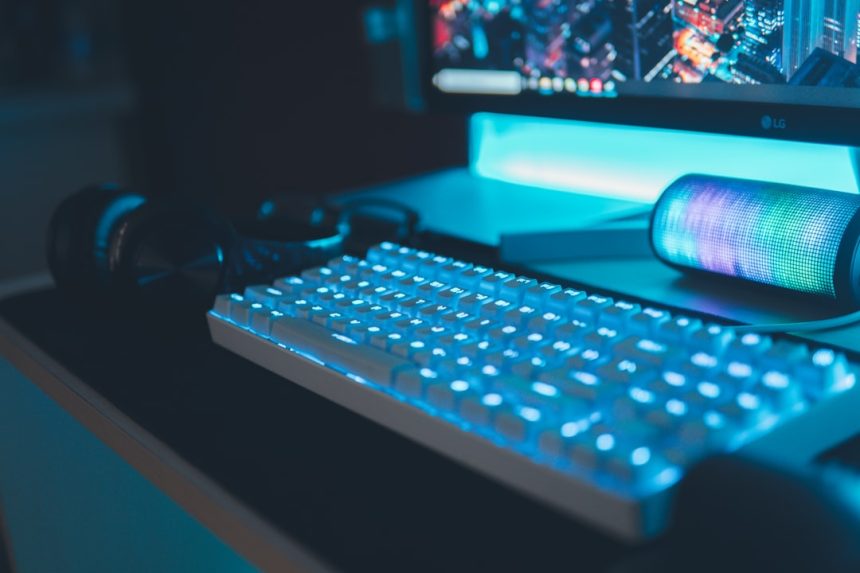With the rise of virtual reality (VR) gaming, laptop users are seeking ways to optimize their experiences beyond what powerful hardware alone can provide. While modern gaming laptops are becoming VR-ready, adding the right accessories can significantly enhance immersion, comfort, and functionality. Whether you’re exploring virtual worlds, battling enemies, or creating 3D art, the right equipment can elevate your VR gameplay to an entirely new level.
1. VR Headsets Compatible with Gaming Laptops
At the core of any VR setup is the headset. For laptop gamers, choosing a headset that is lightweight, compatible with portable setups, and delivers high resolution is crucial. Popular choices include the Meta Quest 2, Valve Index, and HP Reverb G2. These headsets strike a balance between performance and usability with laptops that have USB-C, USB 3.0, and Mini DisplayPort or HDMI outputs.
[ai-img]vr headset, gaming laptop, virtual reality setup[/ai-img]
A VR headset with integrated tracking eliminates the need for external sensors, making it ideal for users on the go or those with limited space. Always verify compatibility with your laptop’s GPU and display output before purchasing.
2. High-Precision VR Controllers and Tracking Accessories
Immersion in VR isn’t just about sight and sound—it’s also about how naturally you can interact with the virtual world. Controllers like the Valve Index Controllers, known for finger tracking, or the Oculus Touch controllers, deliver accurate, ergonomic control.
For advanced setups, external tracking accessories such as the SteamVR Base Stations offer room-scale movement and pinpoint positional accuracy. While they make the setup more complex, they drastically elevate realism in games that involve motion-based interaction.
3. Ergonomic Accessories for Comfort and Support
Spending long hours immersed in VR can take a physical toll. Ergonomics play a vital role, especially when using a gaming laptop, which may already be limited by portability. Accessories such as:
- VR face cushion replacements: Memory foam options can reduce pressure on the face and improve hygiene.
- Adjustable head straps or halo straps: These provide better weight distribution for headsets, increasing comfort during extended sessions.
- Cooling inserts: Built-in fans or airflow-enhancing designs can prevent overheating and lens fogging.
These simple add-ons ensure that gamers can play longer with fewer physical distractions.
4. External Tracking Cameras and Stands
Some VR setups can be further enhanced with the use of tripod-mounted tracking cameras or stands for sensors. These are especially useful for streamers or gamers who use full-body tracking in their VR applications.
[ai-img]vr camera setup, tracking stands, full body tracking[/ai-img]
Using tripods for trackers makes it easy to create a portable tracking zone that can be reassembled quickly, a major benefit for laptop users who may not have a fixed gaming station.
5. USB Hubs and Cable Management Tools
Gaming laptops often have limited ports, and VR headsets typically require multiple USB and video connections. A powered USB hub solves this issue by providing extra ports and power stability. Cable management tools such as ceiling pulley systems or magnetic clips help keep cords out of the way and prevent tangles, reducing the risk of accidents and improving immersion.
6. VR-Ready External GPU (eGPU) Enclosures
For laptop users who want desktop-grade performance, an external GPU (eGPU) is a game-changer. eGPU enclosures allow laptops with Thunderbolt 3 or 4 ports to connect to a powerful desktop-class graphics card. This boosts frame rates, reduces latency, and ensures that intensive VR titles run smoothly.
Though somewhat costly, eGPUs are ideal for users with high-end headsets seeking desktop-level performance without abandoning the portability of a laptop.
FAQs
- Q: Can all gaming laptops support VR headsets?
A: Not all gaming laptops are VR-ready. Check your laptop’s GPU (preferably NVIDIA RTX series or AMD RX series), available ports, and CPU power before purchasing a VR headset. - Q: Is wireless VR possible with a gaming laptop?
A: Yes, some headsets like the Meta Quest 2 support wireless PC-VR via apps like Oculus Air Link or Virtual Desktop if your laptop has a strong Wi-Fi 6 connection. - Q: Do I need external sensors for VR on a laptop?
A: It depends on the headset. Some, like the Meta Quest 2, use inside-out tracking and don’t require extra sensors, while others like the Valve Index benefit from external base stations. - Q: How important is refresh rate in a VR headset for gaming?
A: A higher refresh rate (90Hz or above) provides smoother visuals and reduces motion sickness, which is essential for comfortable VR gaming sessions. - Q: Are VR accessories universal across all headsets?
A: No, accessories are often brand-specific. Always ensure compatibility with your particular headset model before buying any add-ons.
By combining a powerful laptop with these essential VR accessories, gamers can transform a decent VR setup into an exceptional, immersive experience. Investing in high-quality gear not only boosts performance but also ensures comfort and safety in the world of virtual exploration.









